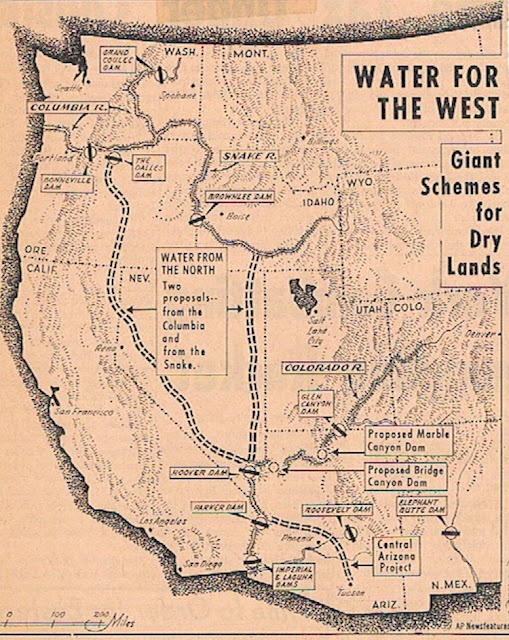Writing about the 1960’s battle to keep the Grand Canyon free of two monster dams has been daunting to think about. First, the story has been written about from various points-of-view. Second, I have two files drawers full of material. But, third, I have no journal or other chronological record of my own to guide a history, as I had for the 1972-5 effort to enlarge Grand Canyon National Park.
One asset I do have is a collection of newspaper clippings from regional newspapers collected during the fight when I was Sierra Club Southwest Representative. I plan to go through these, summarizing them, and hoping that from these pieces I can construct an armature from which to hang the other material I have kept, and eventually a coherent narrative of that 50-years-past adventure.
This little entry was stimulated by a 20 March 1966 article in the Grand Junction Sentinel, a newspaper published in Colorado’s Western Slope that was very much in favor of water development projects large and small. The paper gained prominence by coming from the congressional district of Wayne Aspinall, a pivotal U.S.Representative as Chairman of the House Interior & Insular Affairs, the arena in which the most contentious battles in the dam war took place.
A key element in the debates was the idea held by the Southwest’s water mavens that more water had to be obtained for the uses they foresaw or desired for all the states that shared the Colorado River basin—(southern) California, Arizona, Nevada, Utah, New Mexico, Colorado, and Wyoming. The Colorado itself just did not produce enough.
All these states were well used to the idea of transporting water (using dams, tunnels, canals, etc.) from one drainage basin to another, as for instance, from the Fryingpan River basin into the Arkansas River; the Owens River diversion to Los Angeles. So, when thinking about the Colorado River system as a whole, it took no imagination, but only a scaling up (though an impressive reach), to look at the many-times-larger flow of the Columbia River, and assume it could be the source for the Southwest’s future demands for water.
Two complications: 1. The Columbia basin states’ political leaders did not want to see any of their water diverted to what they saw as the endlessly growing population, thirst, and political power of southern California.
2. A great hunk of the funding for planning and building any such diversion works would come from sale of electric power generated by two dams proposed for construction in the Grand Canyon, and many Americans did not want the Grand Canyon destructively abused (aka “flooded”) for such a purpose.
How all this played out in 1965-8 will be the subject of many yet-to-be-written blog entries. Just as I was beginning, I came across the pregnant article mentioned above. What is remarkable about it is the wide-open ambition it presents given the very public hostility of the Northwest to exporting water from the Columbia River system. Figures in Southwestern water politics just could not stop talking about it.
The AP article was titled “West Thinks Big On Water” and led with the following map, which features two possible routes for future import aqueducts as well as the proposed Grand Canyon dams and a water diversion for Phoenix & Tucson:
The article itself was as brazen as could be in its almost simple-minded boosterism:
Billions would be needed for such a “man-made river up to 1000 miles long”. It may take a decade, though it may never be started. Desalination or weather modification may make import unnecessary. However, “experts say … a Nile-sized aqueduct is the only feasible solution” to the Colorado Basin states squabbling over the Colorado’s water. From the Snake River, the cost would be about $4 billion; from the Columbia, $11 billion.
This cost is one obstacle; also, Washington, Oregon & Idaho want to preserve their great rivers. The Colorado basin states are about to settle their quarrels over the Colorado’s water through the pending compromise $1.6 billion project to build Marble & Bridge Canyon dams and the CAP.
The bill includes a massive survey that would point to the Columbia import. Colorado Basin states have pointed out that (1) much of the Columbia “is wasted into the Pacific”; (2) such a great aqueduct should include irrigation and power projects the Northwest wants; (3) the economic effect, already calculated, from the expenditure of construction funds. All this shows the West is thinking in the grand manner.
Power and irrigation revenues are expected to pay costs back over 50 years, although the “average taxpayer is likely to feel an extra nibble at his pocketbook” since federal funds will be advanced to build the project. However, the diversion will mean the West can buy products of the rest of the country. (End of article summary; emphasis mine.)
The confidence displayed here turned out to be misplaced as far as national opinion and politics went. Yet the first two-thirds of the 20th century did undergird this big thinking. Its proponents did see the future this way, and with cause.
Consider a map of the water systems, planned and built by such thinkers & doers, supplying from non-local sources the agricultural and urban demands of southern California (https://upload.wikimedia.org/wikipedia/commons/7/7c/Water_in_California_new.png):
Compared to such gigantic “big-thinking” as these waterworks represent, our present efforts to deal with water problems are just a muddle of no gargantuan construction projects, the re-ordering of priorities, and the shutting down or rationing of uses. Such lateral thinking would have been inconceivable—even a betrayal of American values— to these believers in the concretizing of water. And the Grand Canyon dams were the prime symbol, the culmination, the sine qua non, of their ’60’s water big-think for the future.
The 50 years since America decided not to build those dams has indeed brought the revolution in thinking we dreamt of back then, a very different big-think broadening as the Environmental Movement was getting underway.



No comments:
Post a Comment